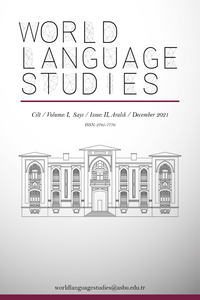Yağmurdaki Kedi ve Tepeler Beyaz Filler Gibi Adlı Öykülerin Yabancı Dil Sınıflarında Karşılaştırılmalı Okunması
Bu makale, evli ve evli olmayan çiftlerin sürdürdükleri tipik yaşamlar vasıtasıyla Hemingway’in insan ilişkilerine bakışına derinlemesine girmek için onun iki kısa öyküsünün karşılaştırılmalı okunmasını sunmaktadır. Birinci öykü Yağmurdaki Kedi evli olan bir çiftin yaşam biçimini betimlerken, ikinci öykü olan Tepeler Beyaz Filler Gibi ise evli olmayan bir çiftin tipik yaşam biçimini ön plana alır. Yazar yaşama aynı noktadan yaklaştığından ve çiftlerin yaşam tarzlarında bir fark görmediğinden anlatıcıyla aynı bakış açısına sahiptir. Yazar, her zaman diğer kişiyi baskı altına almak için daha üst düzeyde olan pozisyonumuzu kullanmaya ve kişinin durumunu kendi lehimize her türlü çevirmeye devamlı hazır olduğumuzdan insansı zayıflıklarımıza ve kuvvetli yanlarımıza ışık tutmaktadır. İster evli ister iyi eğitimli olmuş olsun, ne yazık ki her iki öyküde de istismar edilmek üzere seçilenler kadınlardır. Keskin eleştirel gözle baktığında, okuyucu öykülerdeki yaşamların tipik ve basmakalıp insanlar tarafından sürdürülenler olduğu kolaylıkla anlayabilir. Öykülerde paylaşılan ortak alan öylesine resmedilir ki insanların her hangi bir toplumda aynı davranış biçimini sergiledikleri söylenebilir. Yazınsal (edebi) yapıtların (eserlerin) yabancı dil sınıflarında karşılaştırılmalı okunması, öğrencileri söz konusu dille devamlı karşı karşıya bıraktığından, onların ikinci dil/yabancı dil edinimini önemli bir dereceye kadar kolaylaştırır. Bu sürekli karşı karşıya bırakma, sözcük öğreniminin ve bellekte tutulmasının anlamlı öbekler halinde ve düzenli bir şekilde gerçekleştirilmesini de destekleyebilir.
Anahtar Kelimeler:
Hemingway, Kedi imajı, Beyaz fil, Karşılaştırılmalı okuma
A Comparative Reading of Cat in The Rain and Hills Like White Elephants in Foreign Language Classes
This article proposes a comparative reading of Hemingway’s two short stories to delve deeper into his look at human relationships through typical lives that married or unmarried couple leads. While the first story Cat in the Rain depicts a sort of life a married couple leads, the second story Hills like White Elephants foregrounds a typical life of an unmarried couple. The vantage point the narrator holds is the same, as the writer approaches life from the same point of view and sees no difference between the life styles of these couples. He sheds lights on our human weaknesses and strengths because we are always ready to make use of our superior position to subjugate the other and exploit his or her status every which way. Unfortunately, in both of the stories, women are chosen to be exploited no matter whether they are married, or whether they are well-educated. With a keenly critical eye, the reader can easily understand that the lives presented through the stories are typical and led by stereotype people. The common ground shared by the stories is depicted in such a way that it can be said that people will display the same attitude in any speech community. Comparative reading of literary works in foreign classes helps ease L2 acquisition to a great extent providing constant exposure to the language concerned. This constant exposure also helps boost vocabulary learning and retention in meaningful chunks in a regular fashion.
Keywords:
Hemingway, Cat image, White elephant, Comparative reading,
___
- Abu Zahra, N., & Farrah, M. (2016). Using short stories in the EFL classroom. IUG Journal of Humanities Research 24 (1), 11-24. Akdoğan, Ş. (2018). This novel changes lives: the women’s room, consciousness raising and the confessional mode. Journal of Narrative and Language Studies, 6(11), 194-204. Barın Akman, F. (2019). The others in Charlotte Brontë’s Jane Eyre: a postcolonial-orientalist and feminist reading. Selçuk Üniversitesi Edebiyat Fakültesi Dergisi, 41, 31-48. doi: 10.21497/sefad.586536. Beaty, J. (1996). The Norton introduction to fiction (6th ed.). New York: W.W. Norton & Company. Charters, A. (2007). The story and its writer: an introduction to short fiction (7th ed.). Boston: Bedford/St. Martins. Cixous, H. (2000). Sorties. In D. Lodge & N. Wood (Eds.), Modern criticism and theory (2nd ed.) (pp. 264-270). London: UK. Frost, R. L. (1999). Desert places. In N. Baym (Ed.), Norton anthology of American literature (pp.1871-1872). New York: W.W. Norton & Company. Gillette, M. (2007). Making modern parents in Ernest Hemingway’s “Hills like White Elephants” and Viňa Delmar’s Bad Girl. Modern Fiction Studies, 53(1), 50-69. doi:10.1353/mfs.2007.0023. Gonzalez, A. B. (1985). Teaching Hemingway’s “Hills like White Elephants” to non-native English speakers. English Teaching Forum, 23(1), 6-11. Griffin, P. (2001). A foul mood, a dirty joke: Hemingway’s “Cat in the Rain”. The Hemingway Review, 20 (2), 99-102. doi: 10.1353/hem.2001.0007. Hashmi, N. (2003). “Hills like White Elephants”: the jilting of Jig. The Hemingway Review, 23 (1), 72-83. doi:10.1353/hem.2004.0009. Hemingway, E. (1987). The complete short stories of Ernest Hemingway. New York: Macmillan Publishing Company. Lindsay, C. (1997). Risking nothing: American romantics in “Cat in the Rain”. The Hemingway Review, 17 (1), 15-27. Link, A. (2004). Staking everything on it: a stylistic analysis of linguistic patterns in “Hills like White Elephants”. The Hemingway Review, 23 (2), 66-74. Orwell, G. (1993). Shooting an elephant. In M.H. Abrams (Ed.), Norton anthology of English literature (pp. 2228-2233). New York: W.W. Norton & Company. Őzyőn, A. (2020) A journey of feminist rebellion through Charlotte Perkins Gilman’s short story The Yellow Wallpaper and her novel Herland. International Journal of Language Academy, 8 (5), 115-124. Showalter, E. (2000). Feminist criticism in the wilderness. In D. Lodge & N. Wood (Eds.), Modern criticism and theory (2nd ed.) (pp.308-330). London: UK. Tso Wing-Bo, A. (2014). Teaching short stories to students of English as a foreign language (EFL) at tertiary level. Journal of Language and Linguistic Studies, 10 (1), 111-117. Turan, Y. Z., & Çolak, R. (2018). The use of short story as a teaching/learning tool: “The Necklace” by Guy de Maupassant. Karabük Üniversitesi Sosyal Bilimler Enstitüsü Dergisi, 8 (1), 173-189. Üstün Kaya, S. (2014). Using short stories in ELT/EFL classes. Başkent University Journal of Education, 1(1), 41-47. Űstűn Kaya, S. (2017). Gender and language in short stories. Proceedings of Eurasian conference on language & social sciences, 202-210. Antalya: Turkey.
- Başlangıç: 2021
- Yayıncı: Ankara Sosyal Bilimler Üniversitesi
